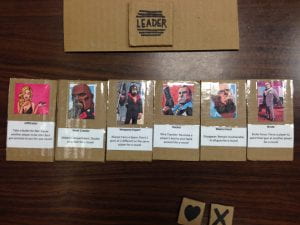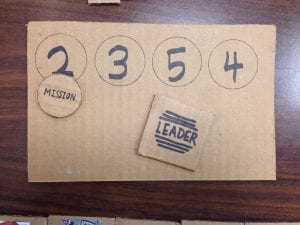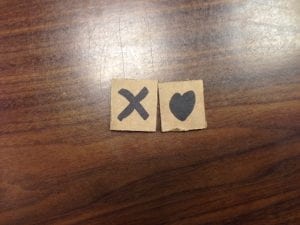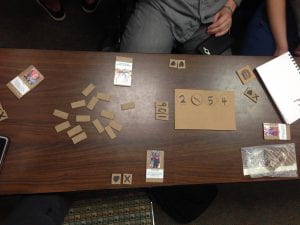Inspiration:
Greed, disloyalty, trust and betrayal always revolve around money and I wanted to create a game demonstrates the power dynamics revolving around this very idea that even when you have a tight group of friends, greed and money always prevails. To demonstrate this concept, I created a bank heist game to simulate the idea of “how well can you really trust someone?”.
Concept and Idea:
- Objective (Win State)
- The player with the most money at the end wins the game
- The Crew (Player Cards)
- The crew consists of 6 players, which simulate the tight knit friendship who all have skills of their own.
- Player cards are not to be shown to anyone other than yourself
- Player Special Skills
- Each player has a special skill that can be used only once throughout the game
- Player cards have special passive skills that enhances the bank loot at the end of the mission
- Bank Job Missions
- There are a total of 4 missions
- Each mission requires the crew leader to pick his crew
- Each mission has a designated bank job leader who chooses the crew members
- Depending on the number of crew members, each player picks a digit from a pile of faced-down numbers and this will total up to be the loot
Player Cards:

Each player has a special ability that they can use only once throughout the game. There are a total of 6 players.
Infiltrator:
Take a Bullet for Me – Cause another player to be shot by a gun pointed at you for a round
Vault Cracker:
Hidden Compartment – Double your loot for a round
Weapons Expert:
Always Carry a Spare – Point 2 guns at 2 different or the same player for a round
Hacker:
Wire Transfer – Re-route a player’s loot to your bank account for a round
Mastermind:
Disappear – Remain invulnerable to all guns for a round
Brute:
Brute Force – Force a player to point their gun at another player for a round
Gun-play Mechanics:
After the leader selects his bank heist crew members and the loot has been tallied. The leader counts down 3-2-1 and everyone draws their guns. There are 2 options open at this moment: you can draw a gun at someone or you holster your weapon
If you draw your gun on someone: that person will lose a life but will still get a share of the loot
If more than one person points their gun at you: you lose a life and you do not get a cut of the loot
Mission Board:

The mission board serves as a marker for what mission you are currently on, how many crew members are participating in the mission and how big your loot will be in thousands. On the first mission, a 2 represents a total of 2 bank heist members participating in this round and a total number of 2 digits that will make up their loot (i.e. 10K). Players who are unlucky and draw 2 0’s will have no loot.
Player Lives:

Each player has 2 lives. When a player is shot he or she will overturn their life card to show an “X” meaning that they have been shot.
How to Play/Gameplay:

- Pick a player (player cards are distributed and not displayed). Only the player knows his or her character
- Move the “mission marker” to the first mission
- Crew leader picks the crew members to join him on the job based on the number on the “mission board”
- Each crew members pick a number from a bag
- The numbers are placed on the table that forms the total amount of loot
- Total amount of loot is revealed
- The leader calls out 3-2-1 and all players either draw out their guns at another crew member or holster their weapons (see Gun-play mechanics)
- Loot is then split evenly between crew members who are still in the game
- Game moves onto the next mission and repeat from step 3
Authors Note:
About The Game:
When creating this game, I wanted to create a game where it evoked emotion and forced the players to experience what it is really like to be somebody else. The idea of this bank heist game came to me when my friends and I were watching a YouTube clip of a bank robbery trailer and a he said that if he chose the bank crew, no one would back-stab each other after a successful heist. I wanted to challenge that idea.
Actual Playtest Observations:
When I play-tested this game in class I was very surprised to see that the game demonstrated the relationship between money and trust. The big question throughout the whole game was “who can I really trust?”. I think that the dynamic between power, money and trust was really highlighted in the later phases of the game. In the beginning, when only 2 members were chosen to go on a bank heist they could only receive a maximum of a 2-digit thousand number. So it was almost always split evenly between the two members. No one really cared about the smaller loot numbers and it was rarely fought over. As the game progressed and more and more players were chosen to participate in the heist the loot trust issues quickly began to grow and people started conversing with each other to try to reason things out. Today I played this game again with Mark, Carter, and Rachel. One of the interesting things that happened during the game was when Mark and Carter discussed about a compromise that if Mark pointed a gun at me this round he would not point the gun at Carter the next round. When the loot stacked up to be 5 digits people became anxious and there was no way to tell who you could trust unless you had protection or a way of assuring the other person that you would do what you say you would do.
Classroom Inspiration and Application:
Much of the inspiration came from “Jejune Institute” and the in class game “Room at the Top”. I have found that I like games that make you embody an emotion or a person and ultimately make you feel a certain way about a story or perspective. “Room at the Top” gave me some insight on hidden agendas and how they affect the dynamics of teamwork. I wanted to incorporate hidden agendas because the game “Room at the Top” demonstrated the awkward dynamic of trust and what are you really here for? question. I added a hidden identity and ability to mimic the hidden agenda. I really liked how the “Jejune Institute” created a story for everyone to follow. I believe in a successful game the story creates flow in the different phases of the game and most importantly the story has to make sense for the game to be believable. The “mission board” idea was an appropriation of a game called “Resistance”. The board serves not only as a tracker for which current level you are on but also a counter for how many people are playing at a certain time.
